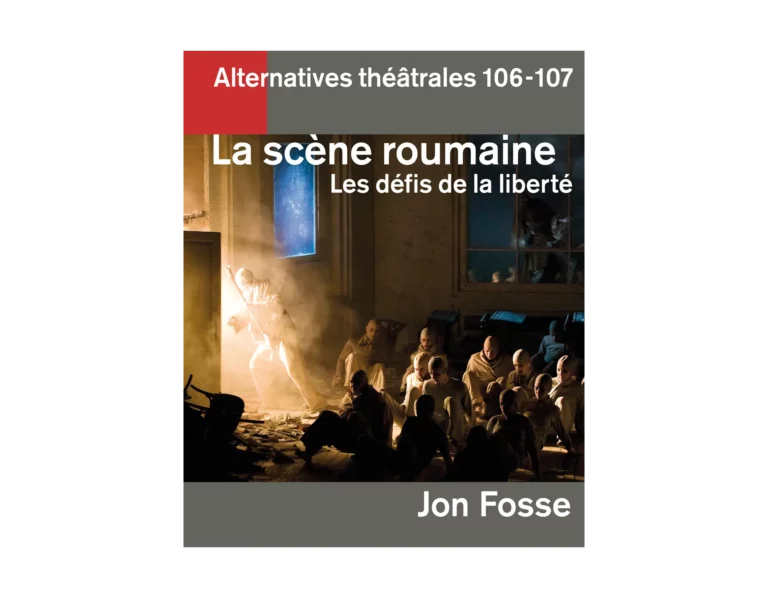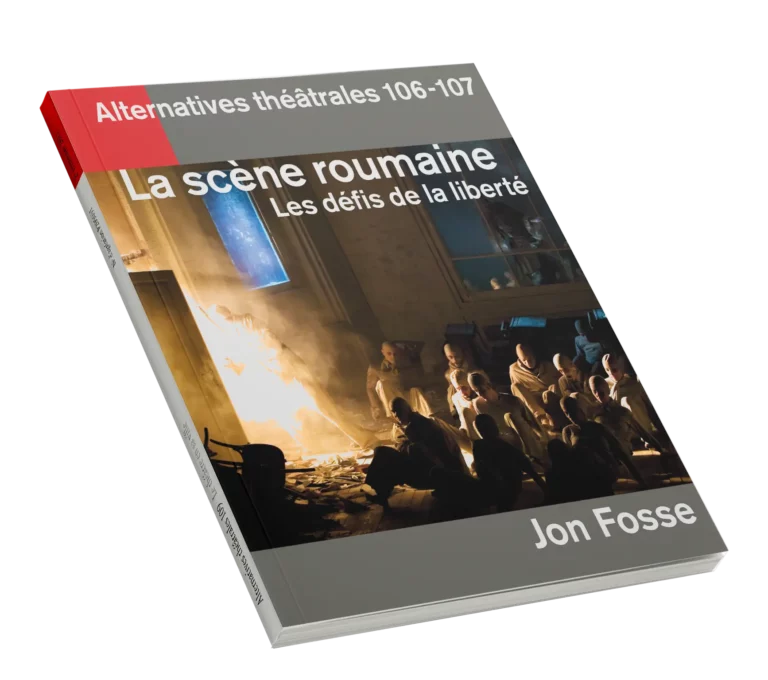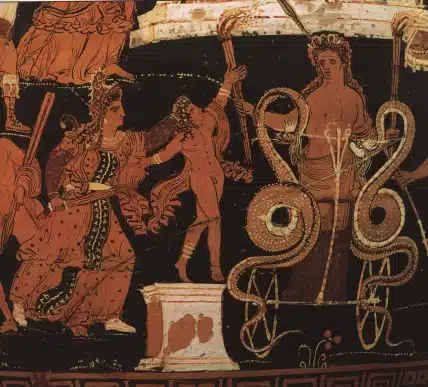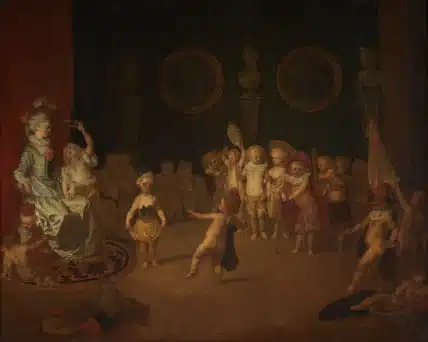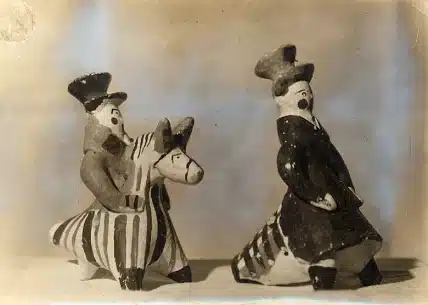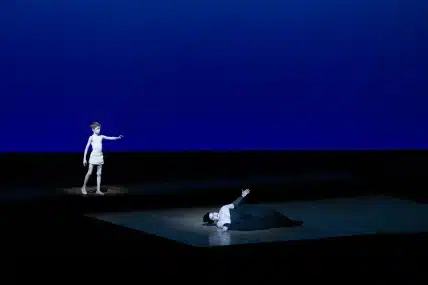IN 2009, Randy Gener wrote, in a cover story for American Theatre, America’s major magazine on the country’s professional theatre, “In the fieldof directing, it is not Romania but America that needs to catch up.” Mr. Gener knows what he is talking about : he is the magazine’s senior editor. And shortly after this essay appeared, the equally distinguished American theatre journal, Theatre, published by the Yale Drama School, devoted an entire issue to Romanian theatre.
This was familiar territory to me. I had become intrigued by Eastern European theatre back in the early 1960s when I saw Matthais Langhoff’s and Manfred Karge’s Threepenny Opera and Das Kleine Mahagonny at the Berliner Ensemble and a touring Moscow Theatre of Satire production of Mayakovsky’s Mystery Bouffe in Paris. My intrigue turned to amazement when I was introduced to Romanian theatre by Andrei Serban’s Fragments of a Trilogy, which I saw in New York in 1975. Mel Gussow, then one of the New York Times’ principal critics, called it “nothing less than a reinvention of theatre” and a series of “excavations into the human heart,” and I had agreed completely. Although I had already written several books on theatre by this time, Serban’s work opened completely new ways for me to approach my directorial work.
One needs to look back to see just how revolutionary this production was. The United States, being a very young country, does not have a historic tradition of its own. Theatre came to America from England in 1702, and for the following two hundred years American theatre was dominated by the classical style of touring British actors – Edmund Kean, Tyrone Power, Charles Kean, Junius Brutus Booth, Lionel Barrymore, and by their descendents – Edwin Booth, John Barrymore and many others. The style they perfected was text-based and conventional, with actors playing their famous roles decade after decade, and handing down their precisely intoned line readings through succeeding generations of progeny and protégés. When a reviewer in one of Edwin Booth’s 19th century productions of Othello described an actor’s performance in the role of Brabantio as “unexceptional,” he was using this as a term of praise – indicating that the actor had made no “exceptions” to the way Brabantio had been played successfully in the past.
By that time the French were also making their contribution to American acting technique as well, with Sarah Bernhardt touring the country nine times, and Charles Fechter and Jean Mounet-Sully taking New York by storm in the role of Hamlet. Faithfulness to the play’s language and its semantic and rhythmic nuances was the norm for these French actors as well, and by the time Jacques Copeau brought his Theatre du Vieux-Colombier to New York in 1913, the American notion of acting and directing was almost entirely bound by the strictures of “fidelity to the text,” as Copeau had made explicit : « tous les mouvements du corps, tous les rythmes de la marche et du geste, tous les tons enregistrés, toutes les intonations et nuances du discours y sont inscrits. Il n’y a pas de tradition plus sûre que celle-là : le texte et l’intelligence du texte.» 1 My own training, along with my colleagues, had been grounded in this “first principle” of American acting.
But there was a second principle, also brought to the United States from abroad – namely, Stanislavsky’s acting system. This system, based on an actor truly “experiencing” his or her role, dazzled American actors and directors when Stanislavsky and his Moscow Art Theatre demonstrated it in New York in 1923, and brought to ten other American cities, playing 380 performances in the United States over the next two years. The Russian system, modified by American citizen (and Ukrainian immigrant) Lee Strasberg and his colleagues at the Group Theatre and the Actors Studio over the years, became what is still known in America as “Method acting” – which became the “second principle” of the national acting style, made internationally famous by film director Elia Kazan and film stars Elia Kazan, Marlon Brando, Paul Newman, James Dean and many others. Strasberg’s notions included the actor’s conscious and deliberate insertion of his own life-experiences into the roles he or she was playing, giving the productions of America’s midcentury somewhat of an autobiographical slant, and leading the major playwrights of that era – the era of my own training – to write autobiographical plays,such as Clifford Odets’ Awake and Sing !, Arthur Miller’s A Memory of Two Mondays, Tennessee Williams’ The Glass Menagerie, William Inge’s Dark at the Top of the Stairs, Frank Gilroy’s The Subject Was Roses, and Eugene O’Neill’s Long Day’s Journey Into Night. Even today, many if not most American dramas center on problems grown children remember having with their own parents and/or siblings. (The trend continues with, for example, Tony Kushner’s Caroline, or Change.)
So really nothing in my country had prepared me for the way that Serban threw Euripides and Sophocles up in the air and let his “fragments” of Medea, Trojan Women and Electra fall back to the floor – in Greek, Latin and a variety of unrecognizable tongues – forming a virtual blizzard of shouts, screams, wails, chants and mesmerizing ruptures of the stage space : half-naked, caged actors rolling wildly through the audience on carts, live animals slithering on the floor and hovering over our heads ; throbbing music and acting that was, as Gussow wrote, “almost unbearably intense.”
We had of course seen many avant-garde plays and Brechtian / Meyerholdian staging techniques on our stages by that time. There was an incipient American avant-garde in New York, with Richard Schechner’s Dionysus in 69, and the Antigone and Paradise Now Julian Beck and Judith Malina’s Living Theatre earning recognition, and other theatres (the Company Theatre in Los Angeles was one) creating innovations elsewhere in the country, but these productions, even when derived from the classics (Dionysus and Antigone) were oddly actor-centered and self-reflective – Beck and Molina acted in their productions and often addressed the audience with their concerns (“I’m not allowed to take my clothes off,” Beck and others screamed in Paradise), and Schechner’s actors dropped their Greek roles to talk about their own acting problems during the performance (at least the one I attended – the work was in part improvised nightly). All in all, these productions were impressive curiosities, attracting a following among academics and theatre specialists such as myself, bold auguries of change more than fulfilled achievements. What they lacked was the qualities that radiated above all else from Serban’s production : awe, amazement, and a link with the eternals of the human condition. For all their bravado (nudity, verbal assault, social challenge), the American innovations were basically temporal, autobiographical and domestic : expressing their troupes’ rebellions against their own repressions rather than visions of the broad course of mankind. What Serban was giving us was the not the vague discomforts of modern-day students and teachers, but the Elusian Mysteries.
Since seeing Serban’s Fragments, therefore, I have avidly sought out Eastern European productions. At the 1981 Berlin Theatertreffen, I was thrilled to see Peter Stein’s Orestia, Langhoff’s and Karge’s Woyzeck, and Peter Zadek’s Jeder stirbt für sich allein. In the following year, I began teaching workshops in Finland, Hungary and Estonia (because my books had been published there in translation), and saw many productions there in the capital cities of each and at theatre festivals in Tampere, Finland and Pécs, Hungary. In the mid-80s, I brought Jerzy Grotowski to my California campus and for the next three years served as his Associate Director for an « Objective Drama Project » that he ran for our department and at the end of that period I co-taught, along with Russian directors Oleg Efremov and Anatoly Efros, a week-long intensive acting workshop for the Swedish Theatre Council. I realized that what I had seen of Serban’s work was part of a larger picture : a postwar eruption of theatrical imagination and creativity that prioritized global issues and the human condition over autobiography and growing-up pains, and explosive staging and dramaturgy over “fidelity to the text.”
It was also a vast prioritization of the director over the actor. It is somewhat strange for me to say this, because I have only recently become aware of it, but despite the fact that I have been a professor and play reviewer for 45 years, and a director (by training and by craft) for 50 years, when I go to a Broadway or regional theatre production in America, more times than not I have no idea, walking into the theatre, who directed it. I will know who the playwright is, even if he or she is a complete newcomer, and the identity of one or two of the actors, but unless the director is a friend of mine, or one the few American directors I track (Daniel Sullivan, Mike Nichols) 2, I won’t know who directed the show until I’m sitting in my seat, reading the program. And even then, I may not know his or her name. European theatre, however, and particularly the Eastern European theatre that I am speaking of, is obviously what the Germans call a Regietheater– a theatre of the director. And that is certainly the key difference between the theatre of Romania and America today.
It wasn’t until 1996 that I saw my first Romanian productions : a double bill of Slawomir Mrozek’s On Foot and The Turkey, directed by George Ivascu with his fourth-year acting students from the Romanian Theatre and Film Academy, performed at a nine-country festival of theatre schools in Budapest where I was a guest instructor. I found the work absolutely extraordinary, and it received a prolonged standing ovation from the audience of students from ten countries – and was the only production at the festival that did so. The following year I saw Silviu Purcarete’s breathtaking Les Danaides in New York, and decided at that moment I must become better acquainted with the current Romanian theatre, and so I did.
I have, by this time, seen over a dozen Romanian productions, in Bucharest, Cluj, Sibiu and one in New York. These include single productions by Lazlo Bocsardi and Serban, two by Purcarete, and several each by Mihai Maniutiu and Gabor Tompa. All have been, in my view, extraordinary, and in the rest of this essay I will try to describe what I thought particularly special about them. I will begin with Laszlo Bocsardi’s Hungarian-language King Lear which the Tamasi Aron Theatre in Sf. Gheorghe had brought to the National Theatre Festival in Bucharest in 2008, mainly because of an exchange I had with a leading Romanian dramaturg in the lobby after the performance. When I asked her what she thought of the production, she replied, “Pretty conventional,” but then seeing me gaping in utter astonishment she quickly clarified her wording : “What I mean, of course, is conventionally avant-garde.” Yes, the text seemed to follow Shakespeare’s play quite closely (though I knowonly a few words of Hungarian, or Romanian for that matter, I know King Lear by heart, having staged it three times), and the staging of the opening scenes were not surprising in comparison of the dozen Englishlanguage productions I’ve seen in the United States, including Peter Brook’s with Paul Scofield, Allen Fletcher’s with Morris Carnovsky, and several others (including two of my own stagings) at various Shakespeare Festivals. But when Bocsardi’s Lear goes into the storm, and encounters the heath’s “poor naked wretches” with their “looped and windowed raggedness” represented by eight near-naked young men crouching in individual glass cages perched standing on waist-high stilts and framed in black brass struts in front of a stage-wide, black-and-white checkerboard backdrop, all I could say to myself was “Windowed indeed!” What amazed me about this set (designed by Bartha Jósef) was not only its astounding originality but its apparent cost : such textually gratuitous scenery (scenery not specifically called-for in the script or dramatic situation), when it appears at all in America, is usually created on the cheap ; few directors or designers have the temerity to commit the money nor the construction work hours to create a setting – particularly for just a portion of the play– of such scale, complexity and aesthetic finesse that was so unrelated to the actions of the play as they might be imagined in a real environment.
Apart from the cages, Bocsardi’s innovations were more interpretive tropes than performative renovations, but they were certainly striking to an American viewer. His King (a tall and generously-proportioned Nemes Levente) was far more ferocious than any I’ve ever seen or even imagined. Terrorizing his daughters from the play’s beginning (even Regan and Goneril are trembling when he marches through the audience and climbs up to the stage), Levente’s face flushes crimson as he roars at the stubborn Kent, then savagely hurls his loving but uncompromising daughter Cordelia to the floor. Even at play’s end, Levente is every inch the king, boldly hoisting Cordelia’s dead body up against a tree, sullenly watching it crumple spasmodically to the ground, then heaving open his own grave (an immense trap door) and, leaping shoulder-deep into it, dragging his dead daughter in on top of him and slamming the grave door shut atop them both. Other unforgettable images included Cordelia’s desperate, full-body lunge at the handsome but faithless Duke of Burgundy, madly kissing him on the lips before the Duke dumps her into the kind but senile hands of a white-headed King of France, and Lear’s return from the hunt with four bloody boar heads (real ones, I’m sure), which remained center stage for the next five scenes, their dead eyes staring defiantly at the audience. Bocsardi’s images were striking throughout, and yet the play of Shakespeare’s was marvelously intact. Even, in some ways “unexceptional,” as with our 19th century Brabantio. In retrospect, and considered among most ofthe productions discussed below, my Romanian dramaturg friend was correct : the Bocsardi Lear was “conventionally avant-garde.”
Another play I saw at the 2008 National Festival was Andre Serban’s lively and sometimes farcical Seagull, which had initially been staged at the Radu Stanca National Theatre in Sibiu. Although I have published several photos of Serban productions(from the American Repertory Theatre in Cambridge, Massachusetts, in my books), this was the first Serban production I had actually seen since his 1975 Fragments in New York. He certainly needed no introduction to the local audience ; half the population of Bucharest, it seemed, had struggled to get their hands on one of the 120 seats the theatre had made available for thisone-night performance, and to reach the theatre door I had to fight my way through at least a hundred hopefuls seeking last-minute ticket returns.
The production’s novelty was in its intra-familial casting : Madame Arkadina was played by Maia Morgenstern, internationally celebrated at the moment for her Mary in Mel Gibson’s film, The Passion of the Christ, while Arkadina’s son, Kostya, was played by Morgenstern’s son, Tudor Istodor. So when Kostya tells Arkadina how impossible it is to live in the shadow of a famous actress-mother, the audience could well believe that real life was not imitating but inhabiting art. “Living the role” did not need Stanislavsky or Strasberg to serve as a catalyst.
Despite this splash of realism, or even super-realismwith regard to the play’s defining mother-son relationship, and what I accepted as the basic faithfulness of the translated Russian text, Serban’s production was filled with infinite and delicate surprises. Most of the audience sits on three sides of the stage, with the main action occurring in a long rectangle within their midst (the entire theatre– audience and stage – having been totally reconfigured after the previous evening’s performance). Translucent fabric walls enclose the two long sides of the audience, providing silhouette renditions of characters as theywalk, run, and cavort to and from Sorin’s estate. A minimalist schema of ordinary (but non-period) furniture – large table, small writing / typing desk, armchair and some sloped-back beach chairs – provides most of the hard scenery of the changing locales, and the more rambunctious physical action centers mainly on the dining table, where Arkadina leaps, in what I’d describe as a full-frontal swan dive, atop the recumbent Trigorin (the very handsome Adrian Matioc) with full Dionysian bravado. While Serban clearly approaches Seagull as a comedy – notably breaking with Romanian tradition, I was told (and American traditionas well) – the play’s underlying sadness still permeates. The great third act, with Arkadina’s conflicted relationships with both son and lover reaching their famous exploding points one after the other, was breathtakingly performed, as was the heartrending fourth act when the no-longer-lovely Nina (Christina Flutur) climbs through a miniature window and flops directly into Kostya’s lap as he types, only to clamber away and dismiss him all over again. Compared to Fragments, this was “Serban lite,” but of course Chekhovis not Euripides and the mysteries of the heart are notthe orgies of Dionysus. The semi-transparent sceneryand tragically-comical staging tropes – the swan dive, the lap flop – are circus moves in what in lesser hands can be a soporific soap opera, and made the production continually engaging and, in a few “Method” moments (Serban has, after all, been living in the United States for more than thirty years), heart-breaking.
Purcarete’s 1997 Les Danaides, performed in New York’s Damrosch Park, had arrived complete with his 100 member chorus ; I doubt that anyone has ever seen a cast this large in an American theatre – even in an opera house. The sheer cost factor of this enterprise – particularly as an avant-garde rendition of a largely unknown 2400 year-old play – is simply unheard of here, where everything thought of as “experimental” is expected to conform to the Grotowskian “poor theatre” in terms of its budget. The production, though certainly grandiose and at times highly provocative, was not a great success : relentlessly grim, performed in French and outdoors, it did not really suit the mood of the summer-in-the-park environment. I, however, was enormously taken by the boldness and bravery of its conception and the confidence with which Purcarete’s actors seized the stage. The play, pieced together from fragments of Aeschylus’s Suppliants, became the director’s catalyst for portraying class conflict and sexual warfare at the same time, and the brutalization of human life through rapacious strivings for power and dominance. The one thing this work made clear to me was that the Romanian people, having survived successive reigns of Hitler, Stalin and Ceausescu over the preceding fifty-odd years, are only too familiar (as are few Americans) with the impending catastrophe that looms persistently on the periphery of what we like to call civilization.
Purc rete’s Waiting for Godot which I saw at the Sibiu Festival ten years later, was a true gem of invention – and a moving experience as well. The set design (by the director and Alin Gavril ) is asymmetrically absurd, and would probably have closed down the production in America, where the Beckett estate refuses to allow directorial liberties not only with Beckett’s texts but with his stage directions. Purcarete’s staging took liberty to its extreme. On the audience’s left was a jungle-gym of steel pipes, with the iconic Beckett tree suspended far above the actors’ heads (they look up into its spreading roots), and a cellophane-like wall, pierced by a solid wood doorframe and door, is the entryway of the famous passersby, Pozzo and Lucky. And on our right : a table and two white-wrapped chairs, on one of which sits a “prompter” who follows the script and, striking a gong from time to time, marks the play’s transitions. When Lucky stands on the prompter’s table to give his speech, clouds of white smoke billow from his febrile brain ; when Beckett’s “Boy” appears, in formal diplomatic dress, carrying sleek attaché case, his mechanical and amplified repetition of Godot’s (or his own) lies prove a metronome of the “hope deferred” that “maketh the something [i.e. heart] sick.” A threepiece combo – violin, cello and piano – concludes each act, the musicians first appearing in full-body rabbit costumes, playing sensually ; then reappearing in Act Two bareheaded and furiously hacking at theirinstruments. Piles of stones are scattered everywhere ; horizontal piping serves as benches for the famous tramps, a globular light bulb creates the “pale for weariness” moon, and a miscellany of fixtures show various states of unfinished or abandoned construction projects. “Infinite adaptability” is Purc rete’s operative concept, as he says in his program note, and for once the absence of direction is the perfect direction itself. Virgil Flonda was the most soulful Vladimir I have ever seen or even imagined (very sadly, he died suddenly a few weeks following this performance), and the padded rotundity of Constantine Chiriac’s Gogo was hilarious and affecting – never so much as when he tried to take off his shoes. “Nothing to be done,” indeed.
The two directors with whose work I am most familiar, however, are Gabor Tompa and Mihai Maniutiu. Both are based in the city of Cluj ; Tompa as the General Director of the city’s Hungarian Theatre and Maniutiu as the Artistic Director of its National Theatre. Both also direct widely abroad, and both have directed English-language productions for American universities : Tompa at the University of California in San Diego, where he is currently the Head of Directing, and Maniutiu at my own campus, the University of California at Irvine, where he was a guest professor in 2009.
The first Tompa production I saw, at the 2008 National Theatre Festival in Bucharest, was Long Friday, an adaptation by Tompa and dramaturg Visky András of Nobel Prize-winner Imre Kertész’s Kaddish For An Unborn Child. Kertész’s Hungarian novel is neo-Beckettian in style ; a solo monologue, it includes at least one paragraph that runs fifty-seven pages. Both novel and adaptation treat Kertész’s autobiographical hero – named simply “B” and self-described as a “Budapest (i.e. citified, non-practicing) Jew” – as he relives his broken marriage, disappointing career as a writer / translator, and failure to father a child in the aftermath of the Nazi Holocaust, during which he (as with Kertész himself) had been sent to concentration camps.
